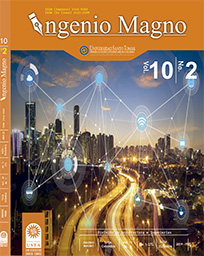Seleção de recursos usando algoritmo LEM para a classificação de sinais EMG
##plugins.themes.bootstrap3.article.main##
Resumo
Downloads
##plugins.themes.bootstrap3.article.details##
DECLARACIÓN DE ORIGINALIDAD DE ARTÍCULO PRESENTADO
Por medio del presente documento, certifico(amos) que el artículo que se presenta para posible publicación en la revista institucional INGENIO MAGNO del Centro de Investigaciones de Ingeniería Alberto Magno CIIAM de la Universidad Santo Tomás, seccional Tunja, es de mi (nuestra) entera autoría, siendo su contenido producto de mi (nuestra) directa contribución intelectual y aporte al conocimiento.
Todos los datos y referencias a publicaciones hechas están debidamente identificados con su respectiva nota bibliográfica y en las citas que se destacan como tal. De requerir alguna clase de ajuste o corrección, comunicaré(emos) de tal procedimiento con antelación a los responsables de la revista.
Por lo anteriormente expresado, declaro(amos) que el material presentado en su totalidad se encuentra conforme a la legislación aplicable en materia de propiedad intelectual e industrial de ser el caso, y por lo tanto, me(nos) hago (hacemos) absolutamente responsable(s) de cualquier reclamación relacionada a esta.
En caso que el artículo presentado sea publicado, manifiesto(amos) que cedo(emos) plenamente a la Universidad Santo Tomás, seccional Tunja, los derechos de reproducción del mismo.
Referências
R. N. Khushaba, S. Kodagoda, M. Takruri, and G. Dissanayake, “Toward improved control of prosthetic fingers using surface electromyogram (EMG) signals,” Expert Systems with Applications, vol. 39, no. 12, pp. 10 731– 10 738, 2012.
A. Dellacasa Bellingegni, E. Gruppioni, G. Colazzo, A. Davalli, R. Sacchetti, E. Guglielmelli, and L. Zollo, “NLR, MLP, SVM, and LDA: A comparative analysis on EMG data from people with trans-radial amputation,” Journal of NeuroEngineering and Rehabilitation, vol. 14, no. 1, pp. 1–16, 2017.
Y. Du, W. Jin, W. Wei, Y. Hu, and W. Geng, “Surface EMG-based inter-session gesture recognition enhanced by deep domain adaptation,” Sensors (Switzerland), vol. 17, no. 3, pp. 6–9, 2017.
V. K, P. LS, N. SN, and P. S, “Development of Surface-EMG Based Single Finger Movement Identification and Control for a Bionic Arm,” Journal of Bioengineering & Biomedical Science, vol. 08, no. 01, pp. 1–5, 2018.
V. Kehri, R. Ingle, R. Awale, and S. Oimbe, “Techniques of EMG signal analysis and classification of neuromuscular diseases,” vol. 137, pp. 485– 491, 2017.
H. F. Hassan, S. J. Abou-Loukh, and I. K. Ibraheem, “Teleoperated robotic arm movement using electromyography signal with wearable Myo armband,” Journal of King Saud University - Engineering Sciences, no. xxxx, 2019. [Online]. Available: https://doi.org/10.1016/j.jksues.2019.05.001
A. Phinyomark, P. Phukpattaranont, and C. Limsakul, “Feature reduction and selection for EMG signal classification,” Expert Systems with Applications, vol. 39, no. 8, pp. 7420–7431, 6 2012.
F. Riillo, L. R. Quitadamo, F. Cavrini, E. Gruppioni, C. A. Pinto, N. C. Pasto, L. Sbernini, L. Albero, and G. Saggio, “Optimization ` of EMG-based hand gesture recognition: Supervised vs. unsupervised data preprocessing on healthy subjects and transradial amputees,” Biomedical Signal Processing and Control, vol. 14, no. 1, pp. 117–125, 2014. [Online]. Available: http://dx.doi.org/10.1016/j.bspc.2014.07.007
U. Cotˆ e-Allard, C. L. Fall, A. Drouin, A. Campeau-Lecours, C. Gos- ´ selin, K. Glette, F. Laviolette, and B. Gosselin, “Deep Learning for Electromyographic Hand Gesture Signal Classification Using Transfer Learning,” IEEE Transactions on Neural Systems and Rehabilitation Engineering, vol. 27, no. 4, pp. 760–771, 2019.
P. Sattam and B. Abdulaziz, “Deep Learning of EMG Time – Frequency Representations for Identifying Normal and Aggressive Actions,” vol. 18, no. 12, pp. 16–25, 2018.
F. Gomez-Donoso, S. Orts-Escolano, and M. Cazorla, “Largescale multiview 3D hand pose dataset,” Image and Vision Computing, vol. 81, pp. 25–33, 2019. [Online]. Available: https://doi.org/10.1016/j.imavis.2018.12.001
R. Li, Z. Liu, and J. Tan, “A survey on 3D hand pose estimation: Cameras, methods, and datasets,” Pattern Recognition, vol. 93, pp. 251– 272, 2019.
A. Carf`ı, F. Foglino, B. Bruno, and F. Mastrogiovanni, “A multi-sensor dataset of human-human handover,” Data in Brief, vol. 22, pp. 109–117, 2019. [Online]. Available: https://doi.org/10.1016/j.dib.2018.11.110
S. Pizzolato, L. Tagliapietra, M. Cognolato, M. Reggiani, H. Muller, and ¨ M. Atzori, “Comparison of six electromyography acquisition setups on hand movement classification tasks,” PLoS ONE, vol. 12, no. 10, pp. 1–17, 2017.
J. S. Kim and S. B. Pan, “A Study on EMG-based Biometrics,” Journal of Internet Services and Information Security, vol. 2, no. May, pp. 19– 31, 2017.
J. F.-s. L. B, A.-a. Samadani, and D. Kuli, “Segmentation by Data Point Classification Applied to Forearm Surface EMG,” vol. 166, pp. 153–165, 2016. [Online]. Available: http://link.springer.com/10.1007/978-3- 319- 33681-7
A. Phinyomark and E. Scheme, “EMG Pattern Recognition in the Era of Big Data and Deep Learning,” Big Data and Cognitive Computing, vol. 2, no. 3, p. 21, 2018.
M. Atzori, A. Gijsberts, C. Castellini, B. Caputo, A. G. M. Hager, S. Elsig, G. Giatsidis, F. Bassetto, and H. Muller, “Electromyography ¨ data for non-invasive naturally-controlled robotic hand prostheses,” Scientific Data, vol. 1, pp. 1–13, 2014.
J. E. Goez Mora, J. C. Londono Lopera, and D. A. Pati ˜ no Cortes, ˜ “Automatic Visual Classification of Parking Lot Spaces: A Comparison Between BoF and CNN Approaches,” in Communications in Computer and Information Science, 2018, pp. 160–170. [Online]. Available: http://link.springer.com/10.1007/978-3- 030-00350-014
R. S. Michalski and L. Saitta, “Learnable Evolution Model: Evolutionary Processes Guided by Machine Learning,” Machine Learning, vol. 38, no. 1, pp. 9– 40, 2000. [Online]. Available: http://dx.doi.org/10.1023/A:1007677805 582.
G. Sheri and D. W. Corne, “The simplest evolution/learning hybrid: LEM with KNN,” in 2008 IEEE Cong.

